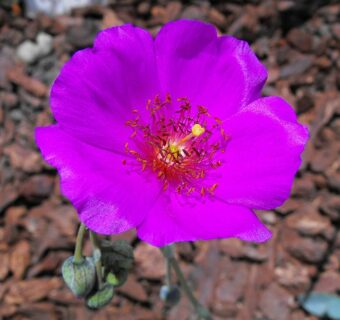In this article, we will discover how to grow the tender perennial of Calandrinia in containers. Calandrinias are a large group of flowering plants that include 100 species of annuals and perennials. The flowers are noted for the colourful trumpet-like or daisy-like blooms that are produced in summer that often come in shades of red, purple and white. The plants are often naturally found in North, South and Central America, along with Australia. It has also been introduced to New Zealand, South Africa, Asia and Europe.

The plant when not in flower is nothing special as it has a basal rosette of long, alternate or opposite green, succulent-like leaves. The flowers often appear on top of these leaves giving their desired look. They are named after the Swiss botanist Jean-Louis Calandrini
Although they are tender perennials and because of their short life span are treated as half-hardy annual bedding plants. They are naturally suited in rockeries and as ground cover plants; they look impressive growing over the edges of containers, where the blooms are allowed to cascade over.
Find out how to grow this unusual bedding plant in containers in this article.
GROWING CALANDRINIAS IN CONTAINERS
If you can find them, it is better to grow them from garden-ready plants, but if you can only find seeds then they can be started this way.
GROWING FROM SEED
You can start your Calandrinias from seed in early March by filling a seed tray with good quality but free-draining, seed sowing compost. On top of the compost sow the seed thinly on the surface and then cover with a 3mm layer of sieved seed sowing compost. Place it in a cool room (no higher than 15 degrees Celsius) and after one to two weeks the seeds should germinate.
Allow the seedlings to grow on and when they are large enough to handle, they can be pricked out and transplanted into 7.5cm individual pots full of multipurpose compost. Allow them to grow on before hardening off in Mid-May for planting out in late May.
At this stage, you can treat homegrown plants from seeds and garden-ready plants in exactly the same way. Calandrinias prefer to be grown in free-draining, sandy compost.

To do this, first, choose a container where you can mix it with other bedding plants or you can grow several Calandrinias in a group (spaced 15 cm apart between them). No matter what you choose make sure, it has plenty of drainage holes. On top of this add a 2.5cm layer of gravel to aid drainage to which you will add a growing media made by mixing 50% by volume building sand with 50% by volume multipurpose compost to 5cm below the rim. The mixture must be free-draining.
As they will be used as annual bedding schemes in containers, you will not need to feed at this Stage. Dig holes in the compost slightly bigger than the root ball it came in the original containers. Place the plant in so that the top of the root ball is at the same level as the top surface of the compost. Backfill with the growing media so that no gaps remain, using more compost if necessary. Firm the plant in and water well.
CARE INSTRUCTIONS
Once established the plants will take long periods of hot dry, weather. You will not need watering unless the plant is clearly showing signs that it needs water (i.e. it is wilting). Place the plant and container in a sunny location that is sheltered from strong winds and heavy rains. As they are used to growing between paving slabs, then they do not need any form of additional nutrients. I would only feed it if it is showing clear signs of being undernourished.
PESTS AND DISEASES

The good news is that the plant has good resistance to pests and does not suffer much from diseases. The only problem is if the roots get too much moisture as this will cause root rot and the death of the plant. This is why it is recommended to grow this annual in a free-draining growing media as demonstrated in this article.
VARIETIES TO GROW
The following varieties are recommended to be grown:
Calandrinia spectabilis is a shrubby succulent with light mid-green, diamond-shaped leaves to which above grows magenta, bell-shaped flowers.
C. grandiflora has large silky purple-pink flowers above a rosette of blue-green leaves. The flowers look like snakeheads in shape.
C. umbellata produces bright magenta flowers that grow on spikes above hairy, greyish-green leaves.
C. ciliata has slightly, fleshy stems and leaves and above these leaves, shiny, silvery flowers on short stems appear.
CONCLUSIONS
In this article, we have discussed how to grow the unusual half-hardy bedding annual of Calandrinia in containers. Easy to grow, easy to care for as long as you grow it in a free-draining, growing media and they do not suffer from pests and diseases.
You do have choices as to what species you can grow and they are colourful to look at. So why not grow some in containers today.
If you have any questions or comments that you wish to make on growing Calandrinia in containers, please do so in the comment box below.
Happy Calandrinia growing.
